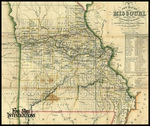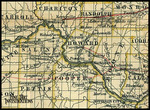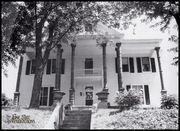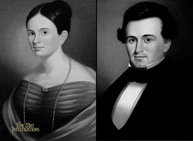Rediscovered Bingham Portraits: Art Historical Documentation
Introduction
Several years ago, images of a pair of antebellum portraits arrived in my inbox: William Franklin Dunnica and Mary Jane Shackelford (Mrs. William F. Dunnica) of Glasgow (Chariton), Missouri. I knew instantly that George Caleb Bingham was the artist. But, as a professional art investigator, I knew the accuracy of a “blink” moment always needs to be tested.

George Caleb Bingham, Martha Jane Shackelford, (Mrs. William Franklin Dunnica), ca. 1837
Oil on Canvas, 24 x 29 inches Private Collection
George Caleb Bingham, William Franklin Dunnica, ca. 1837
Oil on Canvas, 24 x 29 inches Private Collection
Note: The Dunnica portraits are reproduced here in black & white due to the potential for misuse. The colors are vibrant. The artist gave each dark-haired, dark-eyed subject color on their cheeks, just as George Caleb Bingham did. On Mr. Dunnica’s cheeks and under his nose, the artist suggested the slightest hint of a beard, just as Bingham did. In the portrait of Martha Jane Dunnica a blush red shawl subtly complements the deep green of her dress. White lace hides her cleavage. A long strand of coral beads adorns her neck. The background of green /brown with golden highlights is the typical shade used by Bingham.
What?
The logical starting point for researching the authenticity of the portraits was, and is, E. Maurice Bloch’s Paintings of George Caleb Bingham: A Catalogue Raisonné. From hours of poring over Bloch’s definitive text and from a previous portrait search, I knew the name “Dunnica,” but I did not remember these two paintings. I found them listed in the book’s back pages in Section D., “Attributed Paintings.” The scholarly community nearly universally dismisses the paintings Bloch placed in Section D.
To prove or disprove the heirloom portraits’ authenticity with verifiable certainty would require time. Both the portraits’ owner and I had other priorities, but last year, the heirlooms became a top priority for each of us. I set to work.
This is the first of four blogs about the adventure. The first two describe the process of authentication, beginning here with art historical documentation and continuing to connoisseurship in the second blog. The third explains how these two fine portraits ended up in the “trash bin” of the George Caleb Bingham Catalogue Raisonné. In the fourth and final blog, I use the portraits as an entry point to history and tell the stories I discovered behind the portraits. The true tales include a Civil War battle and confrontations with Bloody Bill Anderson and William Quantrill.
Art Historical Documentation
Provenance
The chain of custody was indisputable. Through primary source documents, I followed the subjects’ descendants as they moved from Missouri to another state and then across continents. The documents breathed life into the family’s history as the portraits descended within the family from one generation to the next.
Date of Execution
Comparisons of the portraits with fashion plates and other dated portraits indicated that an artist painted the likenesses between 1836 and 1839.
Region
An accurate portrait authentication requires proof that the subjects and artist were in the same region at the indicated time. In 1836-1839, William Franklin Dunnica and his first wife, Martha Jane Shackelford, lived in the town of Chariton, Missouri, now known as the the town of Glasgow. In 1838, J. Calvin Smith, of the J.H. Colton & Co., drew a map of Missouri.

Lithograph, 30 x 35 inches
State Historical Society of Missouri, Map 859 Sm61
In an enlarged detail of that map below, Chariton, Missouri, can be seen near the center. At a bend in the Missouri River, its name is written above the name of its county, Howard. George Caleb Bingham’s home in Arrow Rock lay less than 20 miles southwest on the other side of the river, under the name of its county, Saline.

Lithograph (Detail)
Subjects
Martha Jane Shackelford (1820-1858)
Martha Jane Shackelford was born on February 25, 1820, in Nashville, Tennessee, the daughter of Thomas Shackelford and Eliza Cheves Pulliam. On December 11, 1836, when she was 16, she married William Franklin Dunnica, 29.
William Franklin Dunnica (1807-1896)
Early Life
William Franklin Dunnica was the son of William Hamilton Dunnica, a wounded veteran of the Battle of Tippecanoe, November 7, 1811. William Hamilton fought for four more years until the end of the War of 1812 in 1815. Not long after he returned home to Woodford County, Kentucky, he and ten-year-old William Franklin filled a keel boat with trade goods. They poled their way to the Mississippi River. When the Mississippi joined the Missouri River, they floated down to heart of Missouri Territory. In the spring of 1818, “after a journey of the greatest difficulty and hardships,” they landed in a French village, Côte Sans Dessein Inside the fort, they set up a trading center. The elder Dunnica, also surveyed, bought and sold land. Eventually, he brought his wife and other children to Côte Sans Dessein.((1817 – Ferguson’s Description of Cote Sans Dessein, “The World of Hannah Chribbs Evans, https://chribbs.wordpress.com/, accessed March 2018; O. P. Williams. & Co., History of Howard and Cooper Counties, Missouri (National Historical Company. 1883), 437.))
Initial Careers
Until his father’s death in 1822, William attended the local schools. Then, he traveled back to Kentucky and attended university for two years. When he returned to Missouri, the town of Jefferson City had nearly subsumed Cote Sans Dessein. With a friend, Calvin Gunn, in 1826, Dunnica founded the first newspaper in Jefferson City, Missouri, The Jeffersonian. The two men lobbied successfully for the young state’s capitol to be sited in Jefferson City. Within a matter of months, Dunnica was offered a clerkship by the State Auditor. While clerking, he also worked as a land agent.((Williams, 438.))
Because of “his well-known business qualifications and his strict integrity and sobriety,” Dunnica drew the attention of a St. Louis businessman, George Collier. Collier hired him in 1831 to work at the United States Bank. “He held this position with great credit to himself, and to the entire satisfaction of the officers of the bank, until President Andrew Jackson ended the national bank system in 1833.”((Ibid.))
Stability
William then opened a store at the mouth of the Chariton river. Collier financed the enterprise while Dunnica was in charge of operations. Three years later, W. F. Dunnica was one of the founders of Chariton, Missouri. He married 16-year-old Martha Jane Shackelford on December 11, 1836. As a shopkeeper, Dunnica owned few slaves. To build a home on hilltop overlooking Chariton for his bride and himself, he would have rented more or hired a contractor. The newlyweds named their home Dunhaven. With quarters for their five slaves, outbuildings, and a conservatory, the estate covered an entire city block. The walls of such a home called out for portraits of the owners.((Dunhaven is currently the oldest structure in Glasgow, Missouri, according to James H Steele., ed., Howard County MO: From Prairie Land to Promised Land, A Remembrance Across Two Centuries (Donning Company. 2016), 136; United States Census Bureau, Sixth Census of the United States, “Household of W. F. Dunican,” 1840, Chariton, Howard, Missouri, page 44, line 15.))

410 Fifth Street, Glasgow, Missouri
Glasgow! Tour Guide & Community Information, ca. 1991
Photograph by Duane Perry((Friends of the Lewis Library of Glasgow [Missouri], Glasgow – The Way It Was (Walsworth Publishing Company, 2001), 134.))
For further biographical information on William F. Dunnica, including his roles in the Mormon War, the Battle of Glasgow, and an encounter with Quantrill’s Raiders and Bloody Bill Anderson, click here.
Artist
The logical choice for a portrait artistfor the Dunnnicas would have been George Caleb Bingham, the only artist working locally during the years 1836-1839. Moreover, the circumstances of the lives of the Binghams and the Dunnicas solidified the conclusion.
George Caleb Bingham
Early Career
On April 14, 1836, in Boonville, Missouri, eight months before the Dunnicas wed, George Caleb Bingham (1811-1879) married Sarah Elizabeth Hutchison (1819-1848). He was 25, and she, 17. They soon moved to St. Louis, Missouri, where Bingham opened a studio. Through exposure to art and to other painters, the young, self-taught artist from the western frontier improved his technique. As winter approached, about the time of the Dunnica wedding, George and Sarah, pregnant with their first child, traveled down the Mississippi River to Natchez, Mississippi.
Natchez was a popular winter haven in the nation’s antebellum years for those who could afford to escape the cold weather of states further north – and who could afford and had the leisure to sit for a portrait. Many artists traveled to Natchez and other such resorts in search of portrait commissions. Bingham, rarely one to pass up an opportunity, followed the trend. On March 26, 1837, Isaac Newton Bingham was born in the Mississippi riverfront town. By May, the Binghams had returned to Missouri with their newborn son, this time to Columbia, where George rented a studio above the law offices of a young attorney, James Sidney Rollins.
Building a Family Life
With savings from his southern tour and from his Columbia portrait commissions, Bingham bought a lot in Arrow Rock, Missouri, on July 27, 1837. To build the house, he needed to earn money for building supplies and labor. He had already portrayed all the prosperous residents of his hometown and of neighboring Boonville. The nearest potentially profitable location was Chariton, later known as Glasgow.((Bingham purchased the lot from Meredith Miles Marmaduke (1791-1864), who would become the eighth governor of Missouri (1844-1844).))
Circumstances
Chariton /Glasgow
In 1836, Chariton /Glasgow was founded by 16 men:
- Joseph A. Blackwell
- John Bull
- Thomas Nicholas Cockerill
- Stephen Donohoe
- William Franklin Dunnica
- James Earickson
- Richard Earickson
- James Glasgow
- James Head
- D. W. Johnson
- William J. Moore
- John Fontaine Nicholds
- Benjamin G. Pulliam
- William Daniel Swinney
- Talton Turner
- Thomas White((Williams, 206. I list 16, although J. Y. Miller, Glasgow, Missouri, historian, helpfully fact-checked this manuscript. He noted that although the number of founders is sometimes listed as 14, the actual number was 16. But, because three of those men, Pulliam, Johnson, and Moore, soon became inactive as landowners, the people of Glasgow count the number of founders as 13.))
Before the end of the decade, Bingham would paint portraits of members of five of the founding families: Cockerill, Donohoe, Dunnica, Pulliam and Swinney. He would also paint other prominent townsfolk: the Beldens, the Lewises, the Harrisons, and the Nicholds.((George Caleb Bingham’s portraits of John Fontaine Nicolds (Bloch #60) and Elizabeth Morton Woodson (Mrs. John Fontaine Nicholds) (#61) and John Hickman Turner (#101) are currently unlocated. Please notify Fine Art Investigations if you know, or have a clue, to their current location.))
Conclusion
Art historical documentation pointed at George Caleb Bingham as the artist of the Dunnica portraits. In the next blog, I explore the third leg of authenticity or the heirloom paintings: Connoisseurship.

